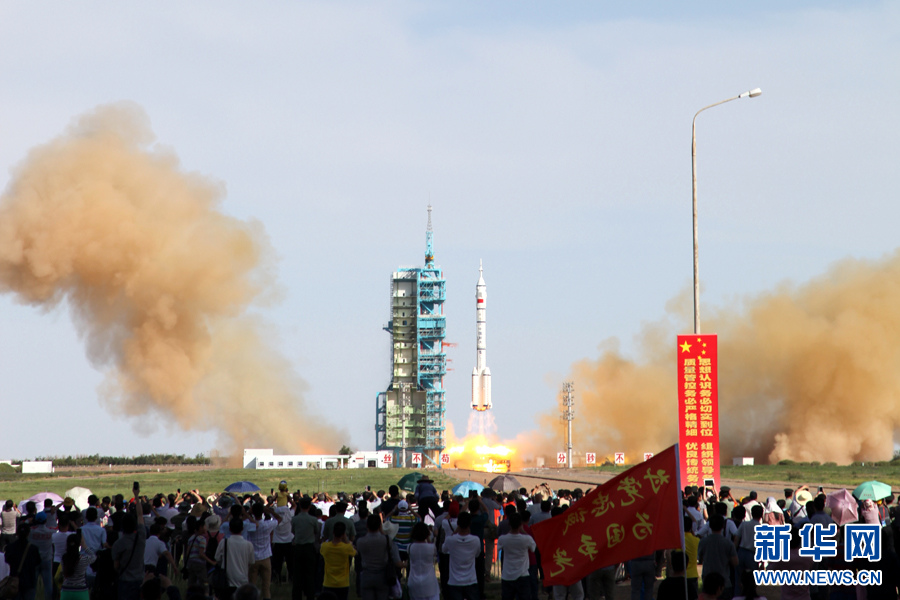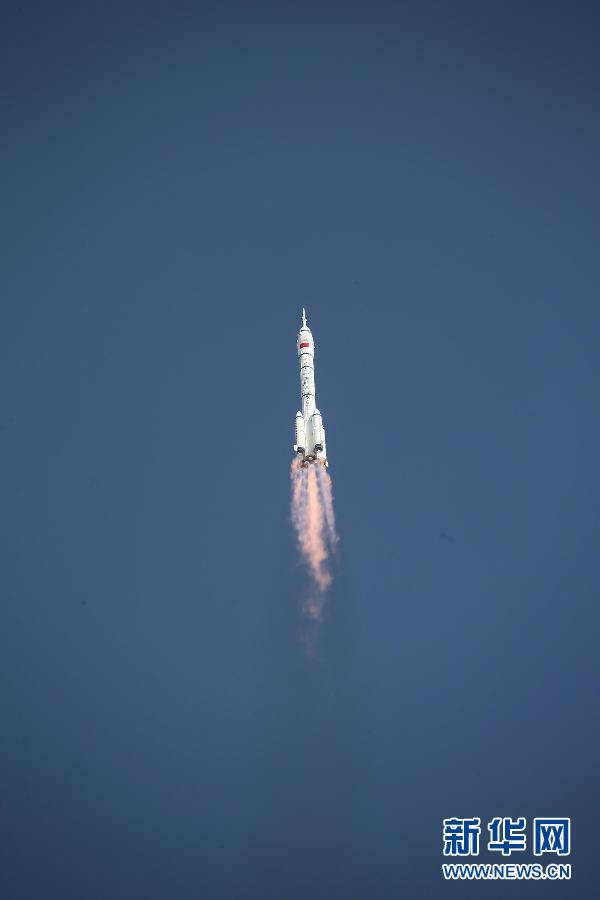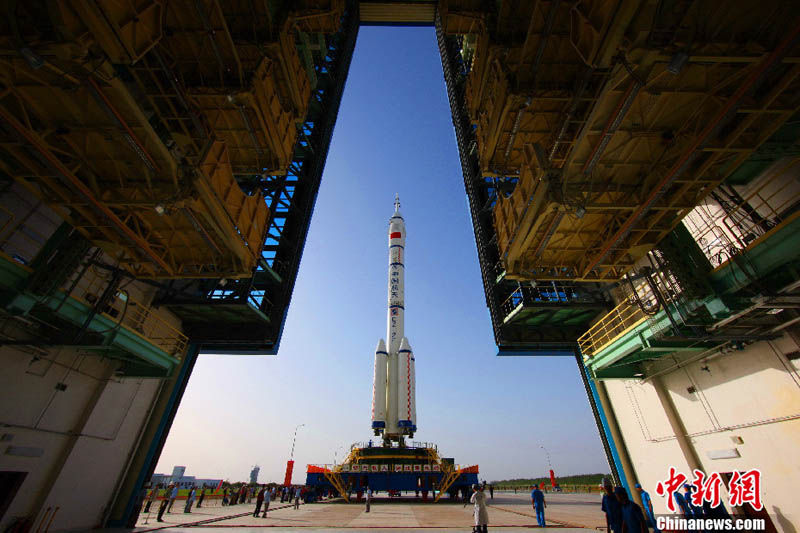How to install the app on iOS
Follow along with the video below to see how to install our site as a web app on your home screen.
Note: This feature may not be available in some browsers.
You are using an out of date browser. It may not display this or other websites correctly.
You should upgrade or use an alternative browser.
You should upgrade or use an alternative browser.
China Space Military:Recon, Satcom, Navi, ASAT/BMD, Orbital Vehicle, SLV, etc.
- Thread starter kvLin
- Start date
hk299792458
FULL MEMBER

- Joined
- Apr 4, 2011
- Messages
- 1,379
- Reaction score
- 8
- Country
- Location
Blessing from the 3 taikonauts of Shenzhou-10...
Henri K.
Henri K.
Last edited by a moderator:
xuxu1457
SENIOR MEMBER

- Joined
- Dec 29, 2009
- Messages
- 4,633
- Reaction score
- 3
- Country
- Location
Shenzhou-10: China launches next manned space mission[/url]
China has launched its latest Shenzhou manned space mission.
Three astronauts blasted away from the Jiuquan base in Inner Mongolia on a Long March 2F rocket at 17:38 Beijing time (09:38 GMT).
The commander, Nie Haisheng, and his crew, Zhang Xiaoguang and Wang Yaping, plan to spend just under two weeks at the orbiting Tiangong space lab.
Wang is China's second female astronaut and she will beam the country's first lesson from space to students on Earth.
The crew's capsule was ejected from the upper-stage of the rocket about nine minutes after lift-off.
It should take just over 40 hours to raise the craft's orbit to the operating altitude of Tiangong some 335km (208 miles) above the planet's surface.
This mission, the fifth manned mission by China and slated to be the longest, is designated Shenzhou-10. It is the latest step in China's plan to eventually put a permanently manned station above the Earth.
Tiangong-1 is the demonstrator. It was launched in 2011 to provide a target to test rendezvous and docking technologies.
The Shenzhou-9 crew - which included China's first female astronaut, Liu Yang - hooked up with the module for nearly 10 days in June 2012.
Nie's team aims to stay a few days longer, and like the crew of Shenzhou-9 will practise both manual and automatic dockings during the mission.
Beijing hopes to launch its fully-fledged station at the turn of the decade.
It is expected to have a mass of about 60 tonnes and comprise a number of interlocking modules.
Like the International Space Station (ISS), it will have long-duration residents and be supplied by robotic freighters.



China has launched its latest Shenzhou manned space mission.
Three astronauts blasted away from the Jiuquan base in Inner Mongolia on a Long March 2F rocket at 17:38 Beijing time (09:38 GMT).
The commander, Nie Haisheng, and his crew, Zhang Xiaoguang and Wang Yaping, plan to spend just under two weeks at the orbiting Tiangong space lab.
Wang is China's second female astronaut and she will beam the country's first lesson from space to students on Earth.
The crew's capsule was ejected from the upper-stage of the rocket about nine minutes after lift-off.
It should take just over 40 hours to raise the craft's orbit to the operating altitude of Tiangong some 335km (208 miles) above the planet's surface.
This mission, the fifth manned mission by China and slated to be the longest, is designated Shenzhou-10. It is the latest step in China's plan to eventually put a permanently manned station above the Earth.
Tiangong-1 is the demonstrator. It was launched in 2011 to provide a target to test rendezvous and docking technologies.
The Shenzhou-9 crew - which included China's first female astronaut, Liu Yang - hooked up with the module for nearly 10 days in June 2012.
Nie's team aims to stay a few days longer, and like the crew of Shenzhou-9 will practise both manual and automatic dockings during the mission.
Beijing hopes to launch its fully-fledged station at the turn of the decade.
It is expected to have a mass of about 60 tonnes and comprise a number of interlocking modules.
Like the International Space Station (ISS), it will have long-duration residents and be supplied by robotic freighters.



shuttler
ELITE MEMBER

- Joined
- Feb 21, 2012
- Messages
- 9,253
- Reaction score
- 3
- Country
- Location
Congratulations for China. Looks like they are catching up. I wonder how NASA is doing?
NASA is many years ahead of us. They have the Curiosity landed in Mars. It has been doing scientific analsysis and flashing back pretty good fotos to NASA.
Also in our news:
China to launch Tiangong-2 and cargo spacecraft in 2015

Tiangong-1 docking with Shenzhou-9 in June 2012. (Source: Framegrab)
13.06.2013 - 11:34
China will launch the Tiangong-2 space lab and its first cargo spacecraft in the next two years in what will be the next step in the country's space station plan, the Beijing Times reports.
The two spacecraft will be launched from China's new satellite launch center in Hainan province, which is expected to come into use later this year.
Tiangong-2 will be used to test and verify refuelling and propellant technology, regenerative environmental control and life support technology in order to lay the foundations for the construction of China's planned space station, which the country aims to put in orbit by 2020.
The Tiangong-2 laboratory module was originally designed to be a backup to Tiangong-1, but recent changes in China's manned space flight programme mean it will be redesigned to allow it to be refuelled by the unmanned cargo resupply vehicle, Zha Xuelei, deputy designer of the cargo spaceship revealed.
According to Zha, the 13-ton craft will be more than 9 meters in length with a largest diameter of 3.35 meters. It will be capable of carrying 6 tons of goods, three times that of Russia's Progress cargo spaceship. It will be able to host a crew of three for up to 20 days.
It will also carry a mission payload including POLAR, a Chinese-Swiss collaboration project to detect black holes, conduct tests of quantum gravity theories and measure the polarization of
gamma ray bursts.
The construction of China's fourth launch site near Wenchang, Hainan Province began in September 2009 and estimated to cost around 5 billion RMB (US$730 million), and offers the advantages being nearer the equator than other sites and being accessible by sea.
- See more at: China to launch Tiangong-2 and cargo spacecraft in 2015 | gbtimes
shuttler
ELITE MEMBER

- Joined
- Feb 21, 2012
- Messages
- 9,253
- Reaction score
- 3
- Country
- Location
An illustration of our 25 ton heavy lift rocket 长征 5 Changzheng 5:

Estimated launch year: after 2014
1st segment: A Lunar Rover inside
2nd segment: A Big Satellite
3rd segment: A Space Module
Environmental friendly. Lox kerosene engine, liquid O2, H fuel

Estimated launch year: after 2014
1st segment: A Lunar Rover inside
2nd segment: A Big Satellite
3rd segment: A Space Module
Environmental friendly. Lox kerosene engine, liquid O2, H fuel
hk299792458
FULL MEMBER

- Joined
- Apr 4, 2011
- Messages
- 1,379
- Reaction score
- 8
- Country
- Location
The 3 chinese astronauts in space laboratory TG-1...
Henri K.
Henri K.
Last edited by a moderator:
What's the current status of the second Chinese lunar orbiter?
It was sent into Deep Space and reached 20 million kilometers in February 2013. Since then I've not heard anything. Has it been deactivated?
Chinese probe in breakthrough outer space travel
It was sent into Deep Space and reached 20 million kilometers in February 2013. Since then I've not heard anything. Has it been deactivated?
Chinese probe in breakthrough outer space travel
rcrmj
SENIOR MEMBER

- Joined
- Jan 5, 2011
- Messages
- 6,322
- Reaction score
- -12
- Country
- Location
What's the current status of the second Chinese lunar orbiter?
It was sent into Deep Space and reached 20 million kilometers in February 2013. Since then I've not heard anything. Has it been deactivated?
Chinese probe in breakthrough outer space travel
no, it appears still travelling into deeper space, it is two years of exceeding its life expectancy
no, it appears still travelling into deeper space, it is two years of exceeding its life expectancy
Any idea how far it has travelled? The distance from Earth to Mars is 54.6 million kilometres and not many countries have sent anything as far as Mars.
I am thinking on the lines whether the probe can be travel outside of the solar system like the 4 American probes.
How Far Into Outer Space Have Space Probes Penetrated
rcrmj
SENIOR MEMBER

- Joined
- Jan 5, 2011
- Messages
- 6,322
- Reaction score
- -12
- Country
- Location
Any idea how far it has travelled? The distance from Earth to Mars is 54.6 million kilometres and not many countries have sent anything as far as Mars.
I am thinking on the lines whether the probe can be travel outside of the solar system like the 4 American probes.
How Far Into Outer Space Have Space Probes Penetrated
on 5th Jan 2013 it reached 10 million km,
on 28th Feb 2013 it reached 20 million km
as of end of May 2013 it has already reached 35 million km and keep travelling into deeper space with good conditions even it is designed for only one year of life expectancy`
hk299792458
FULL MEMBER

- Joined
- Apr 4, 2011
- Messages
- 1,379
- Reaction score
- 8
- Country
- Location
China's first space teaching course will occur on June 20th
Astronauts in good condition after 8-days flight
Henri K.
Astronauts in good condition after 8-days flight
Henri K.
Last edited by a moderator:
hk299792458
FULL MEMBER

- Joined
- Apr 4, 2011
- Messages
- 1,379
- Reaction score
- 8
- Country
- Location
June 23rd at 10:07, Shenzhou-10's astronauts successfully carried out manual docking with TG-1
Henri K.
Henri K.
Last edited by a moderator:
Similar threads
- Replies
- 0
- Views
- 309
- Article
- Replies
- 0
- Views
- 699
- Replies
- 30
- Views
- 2K
- Replies
- 0
- Views
- 436









